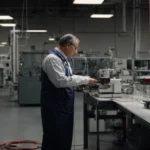To remain successful in a competitive market, restaurant owners need to find ways to streamline operations and cut costs. Automating tasks is a great way to accomplish this, but many food service workers are wondering what this means for their jobs. Keep reading to learn more about the benefits of automation and its potential impacts on restaurant jobs.
The Rise of Food Service Automation

Restaurant automation has been on the rise in recent years as businesses seek to reduce costs and improve efficiency. Automation refers to the use of technology to perform tasks that have traditionally been done by humans. In the foodservice industry, this can include a wide range of operations, including using machines to take orders, handle payment transactions, and clean dishes.
The impact of automating restaurant jobs has been a subject of debate for many years. Proponents of automation argue that it leads to increased efficiency and reduced costs, which can lead to lower prices for consumers and increased profits for businesses.
Opponents of automation argue that it leads to decreased quality and variety in food offerings, as well as decreased customer service. They also argue that it leads to job losses, which can have a negative impact on the economy overall.
The Benefits of Automation in the Restaurant Industry
Automation in restaurants can take many forms, from ordering and payment systems to cooking and cleaning. Automating tasks can make restaurant work easier and faster, improving both the efficiency and the quality of the food service.
Perhaps the most important benefit of automation in restaurants is that it can improve safety. Automated cooking systems can reduce the chance of a human error that could lead to a foodborne illness. Automated dishwashing systems can reduce the chances of employees coming into contact with harsh chemicals. Automated ordering systems improve the accuracy of orders, which reduces food waste and creates a more positive dining experience for customers.
Automation can also improve the efficiency of restaurants. Automated dishwashing systems can clean dishes more quickly and thoroughly than human dishwashers can, while automated ordering systems can reduce the amount of time that it takes to order and receive food.
Automating certain processes also frees employees up to focus on more important tasks, like cooking, plating (or packaging) food items, and customer service.
The Potential Drawbacks of Restaurant Automation

The use of machines to take over tasks such as preparing food and serving customers could lead to a loss of jobs for restaurant workers. This could result in reduced income for these workers and reduced spending in the restaurant industry overall.
In the restaurant industry, jobs that are repetitive and predictable are increasingly being automated. These include tasks such as taking orders, preparing food, and cleaning dishes. Automation has already begun to take over these roles in some restaurants, with machines able to do them faster and more efficiently than humans. As a result, there is concern that many jobs in the restaurant industry will be lost to automation in the coming years.
This poses a problem for those working in the restaurant industry, as it is one of the largest sources of employment in the United States. However, automating certain tasks has the potential to improve working conditions for restaurant employees, either by eliminating the need for workers to perform hazardous tasks or freeing them up to focus on more important ones.
And while some tasks can be automated, there is no replacement for chefs or good customer service.
Overall, the impact of automation on restaurant jobs has been largely positive. Automation has allowed restaurants to become more efficient and has led to the creation of new jobs in the restaurant industry.










